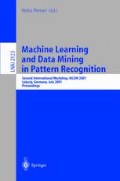Abstract
Machine learning algorithms used in early fault detection for centrifugal pumps make it possible to better exploit the information content of measured signals, making machine monitoring more economical and application-oriented. The total amount of sensors is reduced by exhausting the information derived from the sensors far beyond the scope of traditional engineering through the application of various features and high-dimensional decision-making. The feature selection plays a crucial role in modelling an early fault detection system. Due to presence of noisy features with outliers and correlations between features a correctly determined subset of features will distinctly improve the classification rate. In addition the requirements for the hardware to monitor the pump decrease therefore its price. Wrappers and filters, the two major approaches for feature selection described in literature [4] will be investigated and compared using real-world data.
Access this chapter
Tax calculation will be finalised at checkout
Purchases are for personal use only
Preview
Unable to display preview. Download preview PDF.
References
Cardie, C: Using decision-trees to improve case-based learning; 10. Conf on Machine Learning; Wien; 1993
Devijer, P.; Kittler, J.: Pattern Recognition-A statistical approach; Prentice / Hall; 1982
Duda, R.; Hart, P.: Pattern classification and scene analysis; John Wiley & Sons; 1973
Kohavi, R.: Wrappers for performance enhancement and oblivious decison graphs; Dissertation; Stanford University; 1995
Lim, T.-S., Loh, W.-Y. and Shih, Y.-S.: A comparison of prediction accuracy, complexity, and training time of 33 old and new classification algorithms; Machine Leraning; preprint www.recursive-partitioning.com/mach1 317.pdf; 1999
Martens et al: ‘An initial comparison of a fuzzy neural classifier and a decision tree based classifier’, Expert Systems with Applications (Pergamon) 15; 1998
Michie, D.; Spiegelhalter, D.; Taylor, C: Machine Learning, Neural and Statistical Classification; Ellis Horwood; 1994
Perner, P.; Apte, C: Empirical Evaluation of Feature Subset Selection Based on a Real World Data Set, In: D.A. Zighed, J. Komorowski, and J. Zytkow, Principles of Data Mining and Knowledge Discovery, Springer; 2000
Quinlan, J. R., Comparing connectionist and symbolic learning methods, Computational Learning Theory and Natural Learning Systems; Constraints and Prospects, ed. R. Rivest; MIT Press, 1994
Scherf, M.; Brauer, W.: Feature Selection by Means of a Feature Weighting Approach;Technical Report No FKI-221-97;Forschungsberichte Künstliche Intelligenz, Institut für Informatik, TU München; 1997
See5 / C5; Release 1.10; Quinlan, J. R.; http://www.rulequest.com ; 1999
Spath D.; Hellmann, D. H.: Automatisches Lernen zur Störungsfrüherkennung bei ausfallkritischen Anlageelementen; Abschlußbericht zum DFG-Forschungsprojekt Sp 448/7-3 und He 2585/1-3; 1999
Rauber, T.:Tooldiag-PatternRecognitionToolbox;Version2.1; http://www.inf.ufes.br/~thomas/home/tooldiag ; 1994
Author information
Authors and Affiliations
Editor information
Editors and Affiliations
Rights and permissions
Copyright information
© 2001 Springer-Verlag Berlin Heidelberg
About this paper
Cite this paper
Kollmar, D., Hellmann, D. (2001). Feature Selection for a Real-World Learning Task. In: Perner, P. (eds) Machine Learning and Data Mining in Pattern Recognition. MLDM 2001. Lecture Notes in Computer Science(), vol 2123. Springer, Berlin, Heidelberg. https://doi.org/10.1007/3-540-44596-X_13
Download citation
DOI: https://doi.org/10.1007/3-540-44596-X_13
Published:
Publisher Name: Springer, Berlin, Heidelberg
Print ISBN: 978-3-540-42359-1
Online ISBN: 978-3-540-44596-8
eBook Packages: Springer Book Archive

